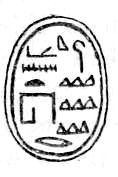
Merneferre Ay was an ancient Egyptian pharaoh of the mid 13th Dynasty. The longest reigning pharaoh of the 13th Dynasty, he ruled a likely fragmented Egypt for over 23 years in the early to mid 17th century BC. A pyramidion bearing his name shows that he possibly completed a pyramid, probably located in the necropolis of Memphis.

The Second Intermediate Period dates from 1700 to 1550 BC. It marks a period when ancient Egypt was divided into smaller dynasties for a second time, between the end of the Middle Kingdom and the start of the New Kingdom. The concept of a Second Intermediate Period generally includes the 13th through to the 17th dynasties, however there is no universal agreement in Egyptology about how to define the period.
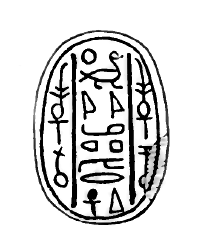
Meruserre Yaqub-Har was a pharaoh of Egypt during the 17th or 16th century BCE. As he reigned during Egypt's fragmented Second Intermediate Period, it is difficult to date his reign precisely, and even the dynasty to which he belonged is uncertain.

The Fifteenth Dynasty was a foreign dynasty of ancient Egypt. It was founded by Salitis, a Hyksos from West Asia whose people had invaded the country and conquered Lower Egypt. The 15th, 16th, and 17th Dynasties of ancient Egypt are often combined under the group title, Second Intermediate Period. The 15th Dynasty dates approximately from 1650 to 1550 BC.

The Sixteenth Dynasty of ancient Egypt was a dynasty of pharaohs that ruled the Theban region in Upper Egypt for 70 years.

The Thirteenth Dynasty of ancient Egypt was a series of rulers from approximately 1803 BC until approximately 1649 BC, i.e. for 154 years. It is often classified as the final dynasty of the Middle Kingdom, but some historians instead group it in the Second Intermediate Period.

The Fourteenth Dynasty of Egypt was a series of rulers reigning during the Second Intermediate Period over the Nile Delta region of Egypt. It lasted between 75 and 155 years, depending on the scholar. The capital of the dynasty was probably Avaris. The 14th Dynasty existed concurrently with the 13th Dynasty based in Memphis. Some of the contested rulers of the 14th Dynasty are commonly identified by Egyptologists as being of Canaanite (Semitic) descent, owing to the distinct origins of the names of some of their kings and princes, like Ipqu, Yakbim, Qareh, or Yaqub-Har. Names in relation with Nubia are also recorded in two cases, king Nehesy and queen Tati. However, the dynasty rulers are not referred to as Hyksos in the Turin kings list.

Semqen was a Hyksos ruler of Lower Egypt during the Second Intermediate Period in the mid-17th century BC. According to Jürgen von Beckerath he was the third king of the 16th Dynasty and a vassal of the Hyksos kings of the 15th Dynasty. This opinion was shared by William C. Hayes and Wolfgang Helck but recently rejected by Kim Ryholt. In his 1997 study of the Second Intermediate Period, Ryholt argues that the kings of the 16th Dynasty ruled an independent Theban realm c. 1650–1580 BC. Consequently, Ryholt sees Semqen as an early Hyksos king of the 15th Dynasty, perhaps its first ruler. This analysis has convinced some Egyptologists, such as Darrell Baker and Janine Bourriau, but not others including Stephen Quirke.
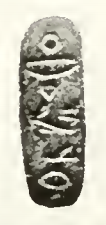
Nebmaatre is the prenomen of a poorly attested ruler of the late Second Intermediate Period of Ancient Egypt. Nebmaatre may have been a member of the early 17th Dynasty and as such would have reigned over the Theban region. Alternatively, Jürgen von Beckerath believes that Nebmaatre was a ruler of the late 16th Dynasty.

Seuserenre Khyan (also Khayan or Khian was a Hyksos king of the Fifteenth Dynasty of Egypt, ruling over Lower Egypt in the second half of the 17th century BCE. His royal name Seuserenre translates as "The one whom Re has caused to be strong." Khyan bears the titles of an Egyptian king, but also the title ruler of the foreign land. The later title is the typical designation of the Hyksos rulers.

Khamudi was the last Hyksos ruler of the Fifteenth Dynasty of Egypt. Khamudi came to power in 1534 BC or 1541 BC, ruling the northern portion of Egypt from his capital Avaris. His ultimate defeat at the hands of Ahmose I, after a short reign, marks the end of the Second Intermediate Period.

Maaibre Sheshi was a ruler of areas of Egypt during the Second Intermediate Period. The dynasty, chronological position, duration and extent of his reign are uncertain and subject to ongoing debate. The difficulty of identification is mirrored by problems in determining events from the end of the Middle Kingdom to the arrival of the Hyksos in Egypt. Nonetheless, Sheshi is, in terms of the number of artifacts attributed to him, the best-attested king of the period spanning the end of the Middle Kingdom and the Second Intermediate period; roughly from c. 1800 BC until 1550 BC. Hundreds of scaraboid seals bearing his name have been found throughout the Levant, Egypt, Nubia, and as far away as Carthage, where some were still in use 1,500 years after his death.

Neferkare Khendu was an ancient Egyptian pharaoh of the Eighth Dynasty during the early First Intermediate Period. According to the Egyptologists Kim Ryholt, Jürgen von Beckerath and Darrell Baker he was the sixth king of the Eighth Dynasty.

Nehesy Aasehre (Nehesi) was a ruler of Lower Egypt during the fragmented Second Intermediate Period. He is placed by most scholars into the early 14th Dynasty, as either the second or the sixth pharaoh of this dynasty. As such he is considered to have reigned for a short time c. 1705 BC and would have ruled from Avaris over the eastern Nile Delta. Recent evidence makes it possible that a second person with this name, a son of a Hyksos king, lived at a slightly later time during the late 15th Dynasty c. 1580 BC. It is possible that most of the artefacts attributed to the king Nehesy mentioned in the Turin canon, in fact belong to this Hyksos prince.

'Aper-'Anati was a ruler of Lower Egypt during the Second Intermediate Period in the mid-17th century BC. According to Jürgen von Beckerath he was the second king of the 16th Dynasty and a vassal of the Hyksos kings of the 15th Dynasty. This opinion was recently rejected by Kim Ryholt. In his 1997 study of the Second Intermediate Period, Ryholt argues that the kings of the 16th Dynasty ruled an independent Theban realm c. 1650–1580 BC. Consequently, Ryholt sees 'Aper-'Anati as an early Hyksos king of the 15th Dynasty, perhaps its second ruler. This analysis has convinced some Egyptologists, such as Darrell Baker and Janine Bourriau, but not others including Stephen Quirke.
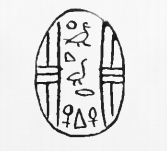
Qareh Khawoserre was possibly the third king of the Canaanite 14th Dynasty of Egypt, who reigned over the eastern Nile Delta from Avaris during the Second Intermediate Period. His reign is believed to have lasted about 10 years, from 1770 BC until 1760 BC or later, around 1710 BC. Alternatively, Qareh could have been a later vassal of the Hyksos kings of the 15th Dynasty and would then be classified as a king of the 16th Dynasty.
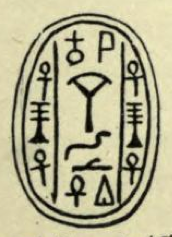
Wazad was an Egyptian pharaoh during the Second Intermediate Period. According to the Egyptologists Kim Ryholt and Darrell Baker, Wazad was a member of the 14th Dynasty of Egypt reigning c. 1700 BC. As a king of the 14th Dynasty, he would have reigned from Avaris over the eastern Nile Delta and possibly over the western Delta as well. The Memphis-based 13th Dynasty reigned over Middle and Upper Egypt at the same time. Alternatively, according to Jürgen von Beckerath and Wolfgang Helck, Wazad was a ruler of the 16th Dynasty and a vassal of the Hyksos 15th Dynasty. This view is debated in Egyptology, in particular because Ryholt and others have argued that the 16th Dynasty was an independent Theban kingdom rather than a vassal dynasty of the Hyksos.
Bebnum is a poorly known ruler of Lower Egypt during the Second Intermediate Period, reigning in the early or mid 17th century BC.

'Apepi was a ruler of some part of Lower Egypt during the Second Intermediate Period c. 1650 BC. According to the egyptologists Kim Ryholt and Darrell Baker, 'Apepi was the fifty-first ruler of the 14th Dynasty. As such he would have ruled from Avaris over the eastern Nile Delta and possibly over the Western Delta as well. Alternatively, Jürgen von Beckerath sees 'Apepi as a member of the late 16th Dynasty and a vassal of the Hyksos rulers of the 15th Dynasty.

Nuya was a ruler of some part of Lower Egypt during the Second Intermediate Period, possibly during the 17th century BC. Nuya is attested by a single scarab seal of unknown provenance. Based on a seriation of the seals of the Second Intermediate Period, the Danish Egyptologist Kim Ryholt has proposed that Nuya was a king of the 14th Dynasty, reigning after Nehesy and before Yaqub-Har. As such, he would have ruled in the 17th century BC from Avaris over the eastern Nile Delta and possibly over the Western Delta as well.
